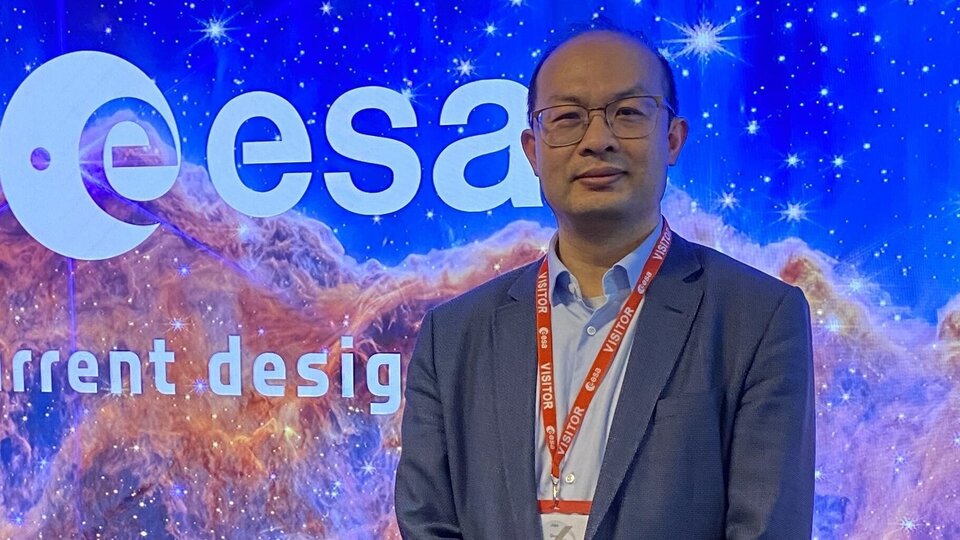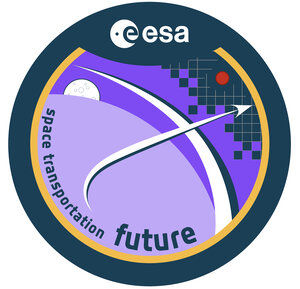One step closer to a CubeSat swarm mission
The next revolution in space technology could be using swarms of small spacecraft working together rather than one much bigger spacecraft. Following an open call for ideas, ESA selected seven projects for mission/system concept study. On 26 April the teams showcased their work in ESA's Concurrent Design facility. Two studies were selected for further development.
It was a busy afternoon at ESA's technical centre, ESTEC. More than thirty participants from a range of research institutions and space companies across Europe came together at ESTEC's Concurrent Design Facility (CDF) to share their innovative ideas on how CubeSat swarms can revolutionise space technology.
Participating in the SysNova Challenge entitled 'Innovative Mission Concepts Enabled by Swarms of CubeSats', the seven teams presented their studies in a competition-style event. Each team was given 90 minutes to present their results from six months of work and their use of ESA Discovery & Preparation funding (up to 100k€) to a panel of ESA experts in charge of judging the ideas according to a set of evaluation criteria and selecting the winners. They then had 30 min each to summarise their conclusions to all other teams as well as to a wider ESA audience.

"The ESA review panel was impressed by the high quality of the work delivered by the teams in such a short time," says Camille Pirat, Systems Engineer in the CubeSat Systems Unit. "These studies have provided an excellent first step to demonstrate how swarms of CubeSats could support future operational mission concepts in various fields, such as telecommunications, Earth observation, astrophysics, space weather or space-based solar power. Technology gaps specific to the mission concepts were identified by the teams, and credible development plans towards an in-orbit demonstration mission were proposed."
Preparing for the future
The seven activities that the Preparation element of ESA's Basic Activities supported under the SysNova Challenge came out of the Open Space Innovation Platform (OSIP) campaign for ideas for Innovative Mission Concepts Enabled by Swarms of CubeSats.

"The Preparation element as the starting point for new missions focuses on providing ESA Programmes, Member States and the scientific community with the necessary information for selecting new mission concepts," says Moritz Fontaine, ESA's Discovery & Preparation Officer. "It was an exciting exercise to see all the participants together sharing their ideas for possible future in-orbit demonstration missions for CubeSats swarms, and we might see such a mission as soon as 2027. Announcing the winners was the highlight of the day, as you could really see the level of engagement in the room."
Keeping in the spirit of the SysNova initiative, all ideas are the result of collaboration between research institutions and commercial companies. "We really encouraged proposals from consortia – partnerships between industry and research institutes – because in our experience this leads to concepts that are realistic from a technical point of view and with a solid implementation plan, while being focused on new innovative applications. The diversity, creativity and quality of the proposed mission concepts was truly impressive. We are looking forward to working closely with the winning study teams to mature their concepts, further develop the technology and eventually implement ground-breaking IOD missions towards future operational swarms," explains Roger Walker, Head of ESA's CubeSat Systems Unit.

The ideas covered a large array of topics. One of the selected ideas used CubeSat swarms to beam solar energy down to Earth, another did the same for fast Internet. Four ideas focused on performing higher-resolution or new types of measurements, either looking down at Earth or into outer space. The seventh idea studied how Earth's upper atmosphere and the satellites flying through it are affected by space weather, so that mitigation measures may be taken for future satellites. Read more about the selected ideas here.
And the winners are..
In an exciting turn of events, the ESA evaluation panel selected two winners, as both proposals received top marks and came in close: COMCUBE-S and AltiCube+. The panel was impressed with all the candidates, the comprehensive conceptual designs, trade-offs that were carefully considered and analyses carried out in a short amount of time and with little budget.

COMCUBE-S is a swarm of CubeSat satellites that will help us to understand the construction of the Universe and its expansion by studying the polarisation of Gamma-ray bursts (GRBs). It will also quickly alert other observatories when GRB events occur, so that they can be studied from all angles during their brief existence. The idea was proposed by the University College Dublin Centre for Space Research, together with IJCLab and Clyde Space.

Alticube+ aims to enable timely and accurate monitoring of global ocean and inland water levels and, therefore, help human beings against water-related hazards. By docking several CubeSats together via long and deployable booms, the AltiCube+ concept will provide a low-cost, long, fixed-baseline (of 10 metres or more) radar altimeter solution using an aggregated CubeSat swarm. The idea was proposed by Delft University of Technology together with industrial partners COMET Ingeniería and ISISPACE.
What comes next?
Each team will be awarded dedicated sessions at the Agency's Concurrent Design Facility with help from ESA experts in order to further elaborate and mature their concepts, before feasibility studies are conducted on their In-Orbit Demonstration (IOD) missions. ESA hopes to launch the first swarm IOD missions by 2027 and have the first operational mission launched by the end of the decade.















 Germany
Germany
 Austria
Austria
 Belgium
Belgium
 Denmark
Denmark
 Spain
Spain
 Estonia
Estonia
 Finland
Finland
 France
France
 Greece
Greece
 Hungary
Hungary
 Ireland
Ireland
 Italy
Italy
 Luxembourg
Luxembourg
 Norway
Norway
 The Netherlands
The Netherlands
 Poland
Poland
 Portugal
Portugal
 Czechia
Czechia
 Romania
Romania
 United Kingdom
United Kingdom
 Slovenia
Slovenia
 Sweden
Sweden
 Switzerland
Switzerland




























